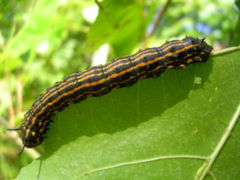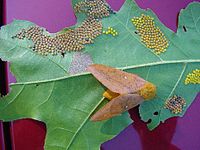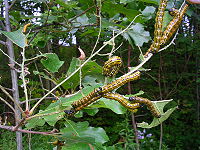- Anisota senatoria
-
Orangestriped oakworm 
Caterpillar Scientific classification Kingdom: Animalia Phylum: Arthropoda Class: Insecta Order: Lepidoptera Family: Saturniidae Genus: Anisota Species: A. senatoria Binomial name Anisota senatoria
(J.E. Smith , 1797)Synonyms - Phalaena senatoria Smith, 1797
The Orangestriped oakworm (Anisota senatoria) is a Nearctic member of the family Saturniidae and subfamily Ceratocampinae. It is one of the more common Saturniids, reaching pest status occasionally in the northern parts of its range. As they are late-season feeders, however, they do little lasting damage to their hosts (most of the energy has been stored already). It is very similar to A. finlaysoni in southern Ontario and A. peigleri in the southern USA.
Contents
Range
Eastern North America, from the edge of the Great Plains to the east coast and from Southern Ontario to central Georgia, Alabama and East Texas. It is not found in Florida and is more common in the north.when eating oak leaves it decreases the size.
Life cycle
There is only one brood a year.
Egg
Eggs are laid on the underside of leaves in large clusters. They take one to two weeks to hatch.
Larva
Larvae are gregarious in the early instars and often do not disperse much in the late instars. The fifth instar is black with yellow-orange stripes on its side, and prominent spiny horns on the second segment of the thorax, and about 5 cm long. Smaller spikes occur on the remaining segments. They feed on oaks in August and September.
Pupa
As with most of this subfamily, when the caterpillars are ready to pupate, they burrow underground. Just before that, they may be seen wandering to locate pupation sites.
Adult
Adults emerge once a year to mate, in mid-June to mid-July. Mating occurs in the middle of the day, and females lay eggs late in the day. As with all of Saturniidae, the adults do not feed. Their mouthparts have been reduced. Females are stout bodied, yellow-orange with a silver-white spot and faint black line across the forewing. There is also a line across the hindwing. Males are much smaller, and red-brownish, but also have the white spot and pale lines. Both are speckled with black spots. Wingspan 3–5 cm.
Food plants
Oaks, Quercus species, especially red oaks (Tuskes et al. 1996). Wagner (2005) also reports chestnut, birch, hazel, hickory and maple.
See also
References
Tuskes, PM, JP Tuttle, and MM Collins, 1996. The wild silk moths of North America. Cornell Univ. Press.
Wagner, DL. 2005. Caterpillars of Eastern North America. Princeton Univ. Press.
- "Anisota senatoria moth". http://www.silkmoths.bizland.com/sasenato.htm. Retrieved 2008-09-21.
See also
Bug Guide to Anisota Butterflies and Moths of North America: Anisota senatoria
Categories:- Ceratocampinae
- Butterflies and moths of North America
Wikimedia Foundation. 2010.



